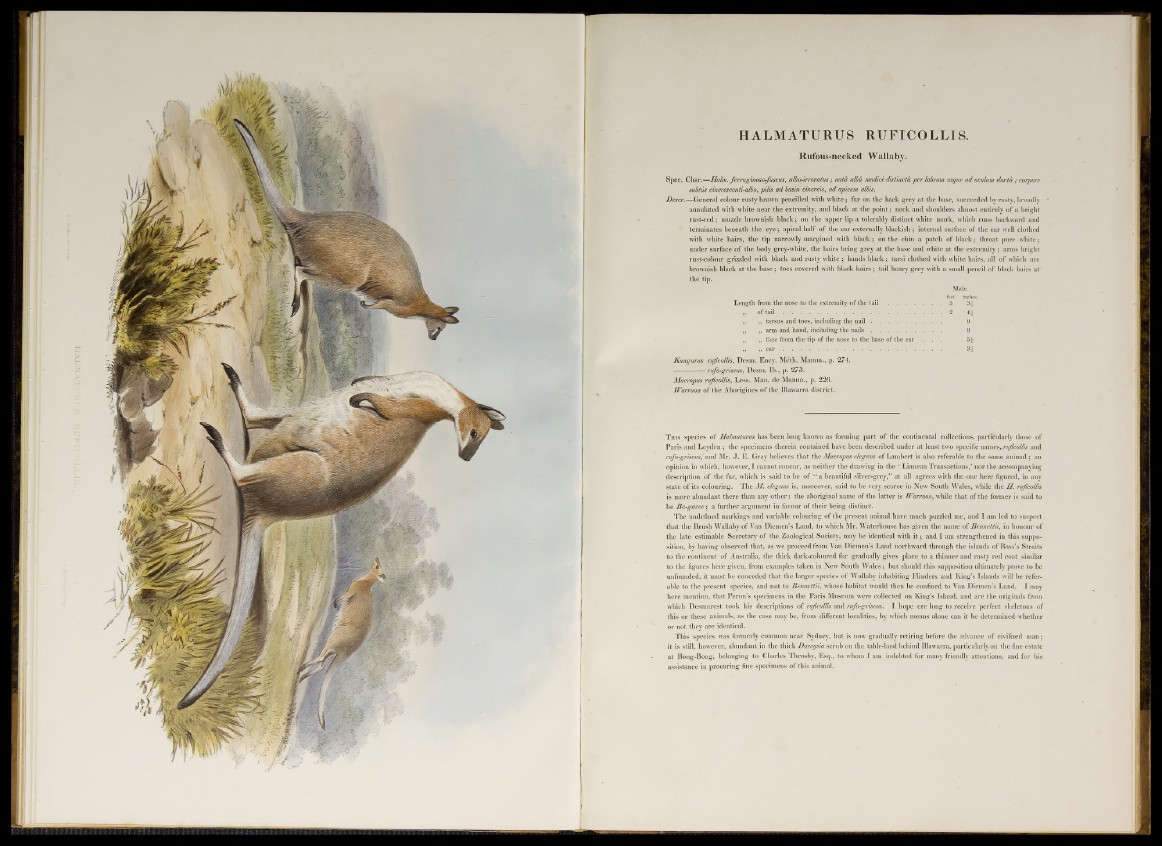
HALMATURUS RUFICOLLIS.
Rufous-necked Wallaby.
Spec. Char.—Halm.ferruginoso-Juscus, albo-irroratus ,• nota alba modice distinctd per labrum usque ad oculum duela ; corpore
subtus cinerescenti-albo, pilis ad basin ciñereis, ad apicem albis.
Descr.—General colour rusty brown pencilled with white; fur on the back grey at the base, succeeded by rusty, broadly '
annulated with white near the extremity, and black at the point; neck and shoulders almost entirely o f a bright
rust-red; muzzle brownish black; on the upper lip a tolerably distinct white mark, which runs backward and
terminates beneath the ey e; apical half of the ear externally blackish ; internal surface of the ear well clothed
with white hairs, the tip narrowly margined with black; on the chin a patch o f black; throat pure white;
under surface o f the body grey-white, the hairs being grey at the base and white at the extremity ; arms bright
rust-colour grizzled with black and rusty white ; hands black; tarsi clothed with white hairs, all o f which are
brownish black at the base; toes covered with black hairs; tail hoary grey with a small pencil o f black hairs at
the tip.
Male.
feet, inches.
Length from the nose to the extremity of the t a i l 5 3£
,, of tail ................................................................................................... 2 4£
„ ,, tarsus and toes, including the n a i l ............................................ 9
„ • „ arm and hand, including the n a i l s ............................................ 9
„ . „ face from the tip of the nose to the base of the ear . . . 5£
„ „ e a r .................................................................................................. 3£
Kangurus ruficollis, Desm. Ency. Meth. Mamin., p. 274.
-------------- rufo-griseus, Desm. Ib., p. 273.
Macropus ruficollis, Less. Man. de Mamm., p. 226.
Warroon o f the Aborigines o f the Illawarra district.
This species o f Halmaturus has been long known as forming part o f the continental collections, particularly those of
Paris and Leyden; the specimens therein contained have been described under at least two specific names, ruficollis and
rufo-griseus,’ and Mr. J . E. Gray believes that the Macropus elegans o f Lambert is also referable to the same animal; an
opinion in which, however, I cannot concur, as neither the drawing in the ‘ Linnean Transactions,’ nor the accompanying
description o f the fur, which is said to be o f “ a beautiful silver-grey,” at all agrees with the one here figured, in any
state o f its colouring. The M. elegans is, moreover, said to be very scarce in New South Wales, while the H. ruficollis
is more abundant there than any other: the aboriginal name o f the latter is Warroon, while that o f the former is said to
be Ba-garee; a further argument in favour of their being distinct.
The undefined markings and variable colouring o f the present animal have much puzzled me, and I am led to suspect
that the Brush Wallaby of Van Diemen’s Land, to which Mr. Waterhouse has given the name o f Bennettii, in honour of
the late estimable Secretary o f the Zoological Society, may be identical with i t ; and I am strengthened in this supposition,
by having observed that, as we proceed from Van Diemen’s Land northward through the islands o f Bass’s Straits
to the continent o f Australia, the thick dark-coloured fur gradually gives place to a thinner and rusty red coat similar
to the figures here given, from examples taken in New South Wales; but should this supposition ultimately prove to be
unfounded, it must be conceded that the larger species o f Wallaby inhabiting Flinders and King’s Islands will be referable
to the present species, and not to Bennettii, whose habitat would then be confined to Van Diemen’s Land. I may
here mention, that Peron’s specimens in the Paris Museum were collected on King’s Island, and are the originals from
which Desmarest took his descriptions o f ruficollis and rufo-griseus. I hope ere long to receive perfect skeletons of
this or these animals, as the case may be, from different localities, by which means alone can it be determined whether
or not they are identical.
This species was formerly common near Sydney, but is now gradually retiring before the advance o f civilized man;
it is still, however, abundant in the thick Daveysia scrub on the table-land behind Illawarra, particularly on the fine estate
at Bong-Bong, belonging to Charles Throsby, Esq., to whom I am indebted for many friendly attentions, and for his
assistance in procuring fine specimens of this animal.